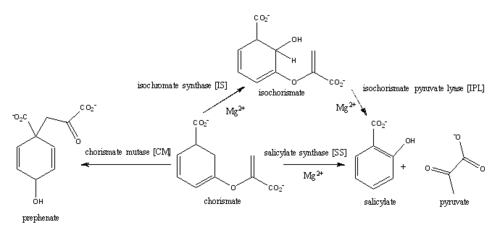This is a default text for your page '. Click above on edit this page' to modify. Be careful with the < and > signs.
You may include any references to papers as in: the use of JSmol in Proteopedia [1] or to the article describing Jmol [2] to the rescue.
Introduction
Mycobacterim tuberculosis salicylate synthase (MtbI) is a highly promiscuous enzyme that has four distinct activities: isochorismate synthase (IS), isochorismate pyruvate lyase (IPL), salicylate synthase (SS) and chromate mutate (CM)(Figure 1). MtbI belongs to the MST enzyme family, which consists of structural homologues (, , , and ) that isomerize chromate to isochorismate. These enzymes are in involved in menaquinone, siderophore, or tryptophan biosynthesis [3]. The salicylate synthase activity of MbtI catalyzes the first committed step in the synthesis of the iron chelating siderophore, mycobactin, in Mycobacterium tuberculosis(Figure 3)[4]. This complex secondary metabolite is essential for both virulence and survival of M. tuberculosis. Therefore, inhibitors of salicylate synthase may serve as potential TB therapies with a novel mode of action. The IS, IPL, and SS activity of MbtI are dependent on pH and the presence of the magnesium ion within the active site, while CM activity is only observed in absence of the magnesium cation. For salicylate synthase activity of MbtI, at pH values below 7.5 isochorismate is the main product while at pH values above 8 the main product is salicylate.

Figure 1: This is the pathway of reactions catilized by wild-type MbtI. Ferrer
et al., 2012
Structure
Image:Active site cleft.png Figure 2: This shows a single sub unit of MbtI, with the active site cleft located at the lower left hand side of the image.
The crystal asymmetric unit was found to contain , however crystal packing and size exclusion chromatography data suggest a monomeric enzyme. There are no significant structural changes between the four monomers excepts from the localized differences in the active site. The overall molecular structure consist of a polypeptide of 450 residues that forms one large single domain with a similar fold to other chromate-utilizing enzymes. The core of the protein is formed by 21 beta-strands folded into a twisted beta-sandwich. The protein's core is then surrounded by 10 alpha helices (Figure 2).
Magnesium ion is required in the active site for the catalytic activity IS, IPL, and SS in MbtI. The magnesium ion is lac
Disease
Mycobacterium tuberculosis is the causative agent of Tuberculosis (TB), an infectious disease that affects one-third of the worlds population. Iron is essential for mycobacterial growth and pathogenesis, M. tuberculosis obtains iron through mycobactin T, a type of siderophore. Mycobactin T is a hydrophilic molecule that has been proposed to be secreted actively into the aqueous growth medium for direct competition with iron-binding molecules of the environment. The core of the Mycobactin T siderophore is derived from salicylic acid which is synthesized from chorismate by salicylate synthase.

Figure 3: Reaction catalyzed by MbtI in the mycobactin biosynthesis pathway.
The salicylate synthase activity of MbtI produces salicylate from chorismate through an isochorismate intermediate. This reaction is Mg2+ dependent. Chorismate is then used in the biosyntheses of Mycobactin T, the siderophore of M. tuberculosis. The siderophore sequesters iron, covering pathogenesis of M. tuberculosis.
Function
Relevance
Structural highlights
Mechanism
A magnesium ion in the active site orients the C1 carboxyl group of chorismate. A lysine residue then serves as a general base for the activation of a water molecule to attack at C2
The catalytic mechanism for conversion of isochorismate to salicylate by MbtI is a sigmatropic, pericyclic mechanism that is pH-dependent. Chromate mutase activity is only observed in the absence of magnesium ion in the active site while salicylate synthase activity is depended on magnesium ion. The active site of MbtI is altered by the removal of the magnesium cofactor causing chromate mutase activity. MbtI has differing binding modes for chromate that leads to different substrate conformations/transition states and resulting in different products.
Inhibition Studies
MbtI Inhibition studies aid in the future design of anti-tubercular agents and broad-spectrum antibiotics. Mimics of the enzyme-bound intermediate of MbtI, isochorismate, prove to be significantly more potent inhibitors than the substrate, chorismate mimics (Alexandra Manos-Turve, 2010). Specifically, 2-hydroxybenzoate-based inhibitors that contain extended hydrophobic enrol ether side chains at C3 in place of the enos-pyruvate side chain found in chorismate and isochorismate.
This is a sample scene created with SAT to by Group, and another to make of the protein. You can make your own scenes on SAT starting from scratch or loading and editing one of these sample scenes.


